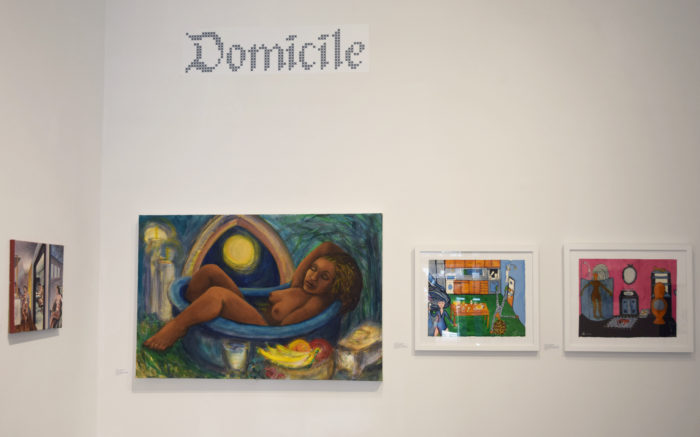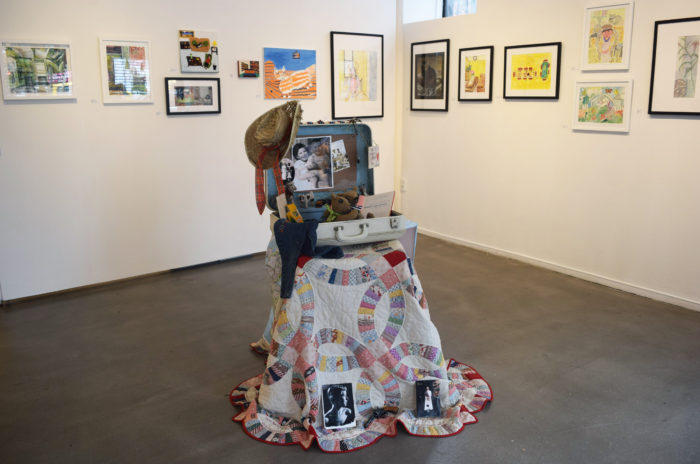
Fountain House Gallery, located in Manhattan’s Hell’s Kitchen neighborhood is currently presenting a group show entitled Domicile. Curated by Audra Lambert, the show features work by approximately 40 artists whose paintings, sculptures, photographs, and mixed media works convey themes revolving around domestic life. These include interior scenes in living rooms, bedrooms, and kitchens alongside depictions of cities or towns where the artists grew up, flanking images of prized possessions and portrayals of loved ones. For instance, Boo Lynn Walsh’s installation entitled Home Is Where the Heart Is consists of a small table covered in a quilt embroidered with both square and circular designs with names of loved ones stitched into the corners. Surrounding the table are various photographs and a book of Mother Goose while on the table itself is an open suitcase with black and white family photos including that of two children in the center, a box of crayons, stuffed animals, and an open book of “Raggedy Ann Stories.” Walsh also has a painting in the show entitled Bain Joyeux (Joyous Bath) that has a very relaxed feeling.

Other notable installations include those by Alyson Vega including a small-scale installation entitled The Princess Bed featuring a bed holding a stack of mattresses inspired by the classic children’s fairytale, The Princess and the Pea.
One love that many of these artists share is that of felines, and at least one cat can be seen in many of the paintings. Artworks in this vein include two similar paintings entitled At Home by Elizabeth Borisov and Winter Dream by Catherine Borisov: two artists who are actually twins! At Home depicts a couple relaxing on their terrace with the woman sitting in a chair with a grey cat in her lap while Winter Dream depicts a family sitting at their dining room table with a decorated Christmas tree and snow that can be seen out the windows. The mother sits in a chair knitting a ball of yarn as her son plays with the grey kitten lying on a small rug.

Also of note is Welcome to My World, Come on in by Linda Bienstock which is a collage made from acrylic and felt depicting a woman relaxing on a lounge chair in her living room next to her coffee table as her black and white cat is sprawled out on her couch against the wall. To the left of the couch is a bookshelf and a painting hanging on the wall.
One work capturing fleeting notions of innocence is Infant Garden by Louise Kavadllo featuring painted in pastel colors. As the name suggests, the piece illustrates a baby resting in a crib placed in a garden replete with various types of flowers, butterflies, and a bunny rabbit. Also of interest is a black and white drawing by Gail Shamchenko entitled Boy in His Playhouse depicting a pre-teen or teenage boy by himself in a house composed of various shapes and patterns, perhaps representing the fact the boy is living in a type of fantasy realm.

Fountain House Gallery supports artists working through mental illness, and this exhibit features works selected from an open call of artists from the Fountain House community, alongside contemporary works by artists Camille Eskell, Max McInnis and Olivia Jane Huffman. Domicile is on view at Fountain House Gallery, 702 Ninth Ave. through Oct. 24. The gallery is open Tue.-Sat. from 11 a.m.-6 p.m.










